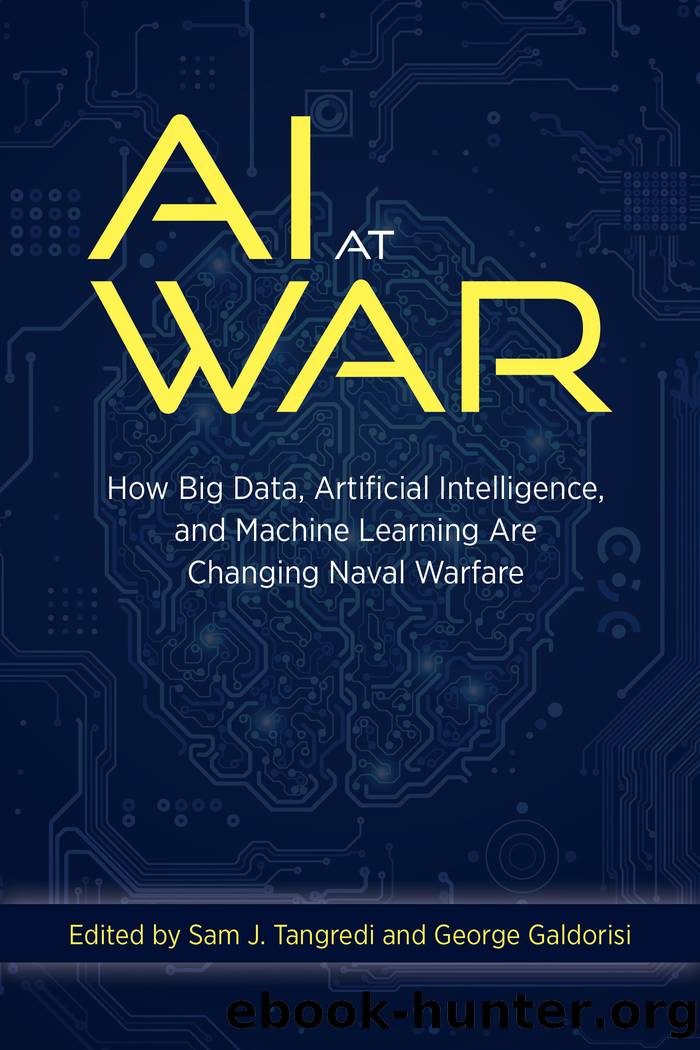AI at War: How Big Data Artificial Intelligence and Machine Learning Are Changing Naval Warfare by Sam J Tangredi & George V Galdorisi

Author:Sam J Tangredi & George V Galdorisi [Tangredi, Sam J & Galdorisi, George V]
Language: eng
Format: epub
ISBN: 9781682476062
Google: 3MPlzQEACAAJ
Publisher: Naval Institute Press
Published: 2021-11-15T23:34:40.737928+00:00
12
AI and Integrated Fires
MICHAEL OâGARA
Such is concentration reasonably understoodânot huddled together like a drove of sheep, but distributed with a regard to a common purpose, and linked together by the effectual energy of a single will.
âAlfred Thayer Mahan1
The merit of concentration, then, in this sense, is its power of permitting us to form our mass in time at one of the greatest number of different points where mass may be required.
âJulian S. Corbett2
Centuries of naval conflict have challenged commanders, and strategists such as Alfred Thayer Mahan and Julian S. Corbett, to determine the proper balance between covering the vast approaches of the maritime domain and massing forces for decisive action. For centuries, commanders have recognized the ability to orchestrate coordinated effects on the battlefield as a key attribute of victorious forces. Victory in ancient battles often went to much smaller forces that could execute a synchronized employment of infantry, archers, and cavalry, as exemplified by Alexander the Great and Hannibal. In more recent history, commanders such as Napoleon Bonaparte and Robert E. Lee were able to distribute their forces and coordinate complex movements to keep opposing forces off balance until they could deliver a concentrated attack meant to cause the maximum physical and psychological damage.
While technological advances in weapons, sensors, and communications have increased a commanderâs ability to coordinate forces and deliver effects over larger areas, their adoption has driven down force size while driving up unit cost. Effectively, this has made every naval platform a high-value unit and has done little to assist the commander in determining the optimal distribution and maneuver scheme for the force. In addition to having fewer physical entities, todayâs commanders must consider operations in several more dimensions than their historical peers did; they must consider maneuver and effects in space, cyber, and across the electromagnetic spectrum as well as the more traditional dimensions of sea, air, and land. The increase in domains of operation, along with a multitude of rules for engagement, have complicated the already complex calculus of coordinating forces to produce integrated effects. The art of directing actions across all these arenas is still emerging in concepts such as integrated fires, distributed maritime operations, and multidomain battle. Fortunately, emerging technological advances in artificial intelligence (AI) may provide the means to manage this increasing complexity. In this chapter, we will explore the implications of AI in helping generate desired effects in support of these integrated fires concepts.
The advent of artificial intelligence and machine learning presents much-needed opportunities to aid maritime commanders in coordinating actions across this expanded battlespace. There are several areas for discussion, many of which have already been addressed in previous chapters in this book. In regard to integrated fires, the role of AI in helping locate, identify, assess, and share potential threats supports the commanderâs decisions to maneuver and engage at the pace of battle. Integrated fires itself is focused on imposing effects upon the enemy. Before discussing the use of AI in coordinating the implementation of those effects, we
Download
This site does not store any files on its server. We only index and link to content provided by other sites. Please contact the content providers to delete copyright contents if any and email us, we'll remove relevant links or contents immediately.
| Automotive | Engineering |
| Transportation |
Machine Learning at Scale with H2O by Gregory Keys | David Whiting(3968)
Never by Ken Follett(3703)
Urban Outlaw by Magnus Walker(3305)
OPNsense Beginner to Professional by Julio Cesar Bueno de Camargo(3226)
Sapiens and Homo Deus by Yuval Noah Harari(2941)
Will by Will Smith(2734)
A Short History of Nearly Everything by Bryson Bill(2578)
Hooked: A Dark, Contemporary Romance (Never After Series) by Emily McIntire(2463)
Rationality by Steven Pinker(2228)
Borders by unknow(2143)
Holy Bible (NIV) by Zondervan(2055)
The Becoming by Nora Roberts(2030)
The One Percenter Encyclopedia by Bill Hayes(1754)
Freedom by Sonny Barger(1742)
HBR's 10 Must Reads 2022 by Harvard Business Review(1738)
A Short History of War by Jeremy Black(1724)
Five Ways to Fall by K.A. Tucker(1665)
Girls Auto Clinic Glove Box Guide by Patrice Banks(1653)
Go Tell the Bees That I Am Gone by Diana Gabaldon(1645)
